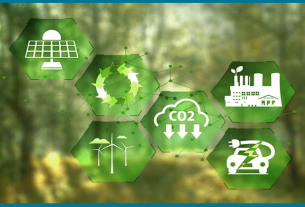Author Nancy Burrell highlights the importance of accurate carbon accounting and describes her team’s latest research into the accuracy of current methods for measuring carbon in scrublands.
Traditional methods like the i-Tree Eco model, effective in urban and forestry settings for estimating carbon storage in trees, are based on the growth patterns of plantation trees (trees grown in herbivore-free landscapes).
But how does browsing at the Knepp rewilding project affect the biomass balance of scrub?
In our study, we tested the assumption of a 0.26 root:shoot ratio of biomass on our destructive samples, which revealed a startling fact: the actual root:shoot ratio stands at 1.07, over four times higher than current models predict.
These findings challenge the traditional view that herbivore browsing stunts tree growth and reduces biomass, and rather show that, under browsing pressure, trees reallocate their biomass, potentially enhancing their carbon storage capacity in scrubland environments.
We have been ignoring what happens underground.
Rewilding and climate change
Rewilding has emerged in recent years as an incredibly powerful way to restore biodiversity. Projects like Knepp in West Sussex demonstrate how quickly wildlife returns once habitat bounces back. The rarity of the species spontaneously colonising rewilding sites has been one of the biggest surprises of the process.
With regards to climate change, however, rewilding is often dismissed as irrelevant, inadequate, and ineffective in comparison to other solutions, such as tree-planting.

I’ve never understood this. If soils are functioning again, wetlands are returning, and trees and vegetation are naturally regenerating, surely these new landscapes must be sequestering substantial amounts of carbon?
A particular blind spot, it seems to me, is the carbon-accumulating potential of woody shrubs such as hawthorn, blackthorn, sallow and oak – species that are characteristic of scrubland and hedgerows. We’ve been so fixated on trees that we’ve neglected the smaller, non-forestry species. We have no idea how much carbon they might store not only above ground but below ground too, in their roots, and how this storage maybe stimulated by the browsing of the free-roaming herbivores that drive rewilding projects.
My visits to other landscapes shaped by herbivores sparked a fascination with the responses of plants to browsing.
In Cretan wood pastures, for example, open-grown oaks have been sculpted by centuries of sheep browsing. Favouring thorny structures, compact leaves, multiple stems, and reallocating biomass to their roots, these oaks have shifted their growth strategy as a defensive mechanism. It’s a remarkable transformation. These trees essentially create their own armour against herbivory. Once they reach a certain height, out of the sheep’s reach, they revert to conventional oak trees. This phenomenon mirrors what has been observed at Knepp, where herbivore pressure has shaped woody vegetation into a kind of topiaried sculpture park.
In order to test this, we set out to extract 39 trees across five different species of tree (oak, sallow, hawthorn, blackthorn and dog rose) from the rewilding project, roots and all.

When we applied the i-Tree Eco model to more than 1500 trees at Knepp, we found that only two individual trees had species-specific equations, with the rest being assigned proxies. The model, which predicts biomass from measurements of tree height and diameter (dbh) makes sense when measuring a tree that is growing in a woodland plantation or a city.
Our investigation into this allometric relationship for trees at Knepp, however, told a different story.
For trees growing below the browse line (less than 2.5 meters), there was no correlation between their height and width. This lack of correlation suggests that trees in rewilded areas adopt a different growth strategy. Rather than focusing on height and width, they prioritise developing protective mechanisms.

Next steps
An intriguing question to consider is how browsing pressure affects trees’ long term carbon storage potential. Typically, it is assumed that trees will reach a maximum height, and consequently their carbon storage capacity. But what if browsing delays this growth, and thereby prolongs the tree’s role as a carbon sink? Increased investment in root structures and thorny defences could delay a tree’s attainment of maximum height, and thus extend its duration as a carbon accumulator.
Rewilding offers an alternative pathway in combating climate change and one that can enhance multiple ecosystem services.
Our study lays the groundwork for future research and calls for a re-evaluation of ecological monitoring and carbon accounting methods in this era of rewilding. It advances our understanding of carbon storage in rewilded landscapes and underscores the need to align our ecological assessment tools with these dynamic ecosystems.
As we delve further into rewilding projects, adapting our methodologies to accurately capture their ecological value becomes imperative for the success of these projects and their broader environmental goals.
Read the full research: “The inadequacy of current carbon storage assessment methods for rewilding: A Knepp Estate case study” in Ecological Solutions and Evidence.

